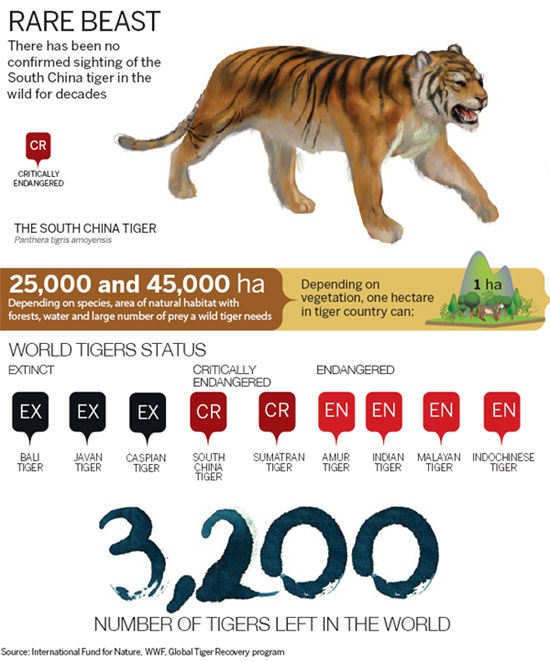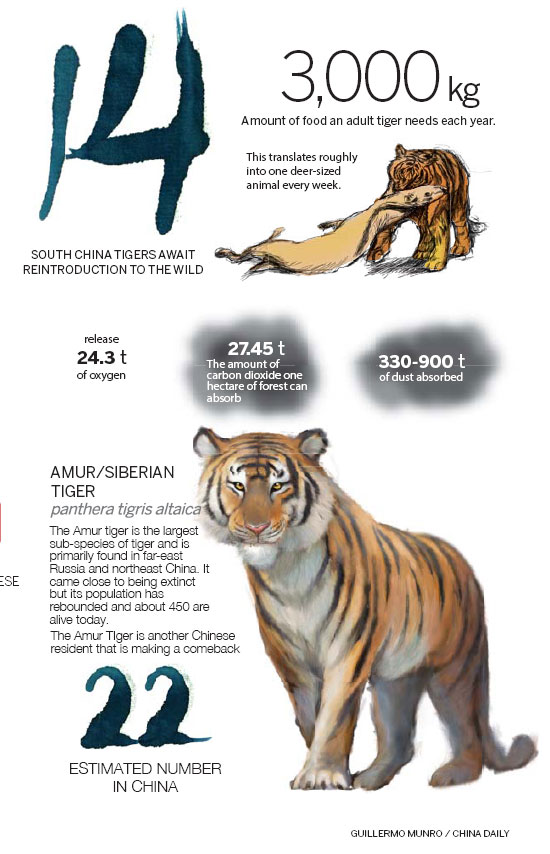


Training for the wild for South China species 'going well' in South Africa
China is still awaiting a date for the arrival of the offspring of South China tigers it sent to South Africa in 2003.
Five tigers were sent from zoos in China to South Africa that year in the hope that those bred in captivity can be released into the wild after training. The tigers' arrival was scheduled for 2008 if things went well.
However, the plan has had to be delayed.
The tigers are doing well in South Africa. With the second generation of these animals having produced cubs, the number of Chinese tigers there has reached 14, and they have acquired the ability to live and hunt in the wild.
The saga began in 2002 when Save China's Tigers, an international charitable foundation, and the State Forestry Administration's Wildlife Research and Development Center reached an agreement to take a few tigers bred in captivity to South Africa and train them to regain their hunting instincts.
The trained tigers' offspring will be relocated and released into pilot reserves in China, while the original animals remain in South Africa to continue breeding.
"The tigers are ready to come, but when will the country be ready to receive them?" asks Quan Li, founder of Save China's Tigers.
Lu Jun, head of the general office at the Wildlife Research and Development Center, says there are two reasons for the delay.
"First was the delay in breeding, as the first tigers to come to China were to be selected from second-generation South China tigers born in South Africa," he says.
"The second reason was a delay in establishing pilot reserves in China, particularly due to problems with the relocation of people living inside the selected nature reserves."
He says China is building a primary base at the Meihuashan Chinese Tiger Breeding and Rehabilitation Center in Fujian province and is preparing to welcome the tigers.
"The base is scheduled to be finished by the end of this year," he says. "But this has not been finalized."
According to Lu, once the tigers born and raised in South Africa become used to their new environment and prey, they will be sent to natural protection zones at Houhe in Hubei province, Matoushan in Jiangxi province and Hupingshan in Hunan province.
But Quan Li says the tigers cannot arrive before work on fence-building and prey recovery is completed in the zones.
Yan Xun, the State Forestry Administration's chief engineer for wildlife conservation, says the nation is accelerating the plan for the tigers' arrival, but as the projects need approval from different levels of government, the exact date is up in the air.
Scientists now suggest that Xishuangbanna in Yunnan province may be an ideal habitat for the tigers.
"The natural rain forests there are abundant, have a rich prey base and, most importantly, Indochinese tigers have already been there," says Feng Liming, a wildlife professor at Peking University.
She says the latest research shows that the genes of Indochinese and South China tigers are basically the same, so locating South China tigers there should not be a problem.
However, Lu Jun says there is not sufficient scientific proof to show that the two subspecies are the same.
Hua Ning, China program director at the International Fund for Animal Welfare, questions the training to return tigers to the wild, saying there has been no successful example of this worldwide.
But scientists confirm the role that such training played in saving the South China tigers, in an assessment report made in October 2010 at Laohu Valley Reserve in South Africa.
David Smith, a professor of wildlife studies at the University of Minnesota, an expert who worked on this project, says the training has been going well in South Africa and the tigers from China are quite capable at hunting.
"This would be the first successful tiger rewilding," Smith says. "We all look forward to seeing China take a lead in reintroducing the tigers. This would set an example to many other countries."
Before this program started, no South China tiger had been seen in the wild, and only around 70 are in captivity, all in Chinese zoos.
This tiger subspecies, which was native to Fujian, Guangdong, Hunan and Jiangxi provinces, has been classified as critically endangered by the International Union for Conservation of Nature and Natural Resources since 1996 due to a low density of prey, widespread habitat degradation and fragmentation and other human pressures.
In the 1950s, only six South China tigers were seen in the wild, says Yan, the wildlife official.
"For the South China tiger, the only ones available for rewilding and reintroduction into the wild are those from the small captive population in Chinese zoos, which are direct descendants of the six wild tigers caught in the 1950s," he says.
Hunting skills
Quan Li, the founder of Save China's Tigers, says that in the wild, tiger cubs acquire and develop hunting and survival skills from their mothers. This may occur over a period of up to two-and-half years.
"Tigers bred in captivity lack these essential hunting and survival skills," Quan says.
She adds that although some tigers may be able to kill prey instinctively, they may not possess the required skills, patience and development for survival in the wild.
"Therefore, it is essential that tigers develop adequate hunting skills before they are reintroduced as free-ranging predators," says Quan.
For this reason, she and her team decided to invest their resources in securing an area in South Africa, which has affordable land, abundant prey and rich experience in wildlife expertise.
After the first two Chinese tiger cubs arrived in South Africa in September 2003, they underwent a 30-day quarantine period at the National Zoological Gardens in Pretoria before being relocated to the Laohu Valley Reserve for training for the wild.
A second pair of tiger cubs arrived from China in November 2004.
Both sets of cubs underwent rewilding training, while a fifth animal was sent in April 2007 at the age of 4 specifically for breeding purposes. It replaced a male tiger that died in 2005 from pneumonia and heart failure.
The rewilding methods used there were originated and developed by Gus van Dyk, former carnivore manager at Pilanesberg National Park in South Africa.
yangyao@chinadaily.com.cn
(China Daily Africa Weekly 08/02/2013 page24)
